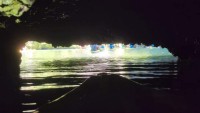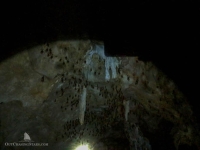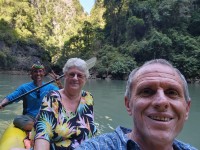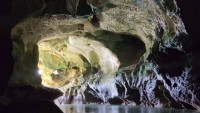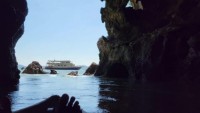Sunday, October 1, Day 5
 Exploration day to Phang Nga Bay! We booked a day excursion with John Gray’s Sea Canoe to explore sea caves and inner lagoons among the marine limestone rock islands in the Phang Nga Bay in the northern reaches of the Andaman Sea off the northeast coast of Phuket. The Hong by Starlight tour starts midday and ends after dark thereby missing the most crowded times. We loved the all-inclusive tour that included transport to and from our hotel.
Exploration day to Phang Nga Bay! We booked a day excursion with John Gray’s Sea Canoe to explore sea caves and inner lagoons among the marine limestone rock islands in the Phang Nga Bay in the northern reaches of the Andaman Sea off the northeast coast of Phuket. The Hong by Starlight tour starts midday and ends after dark thereby missing the most crowded times. We loved the all-inclusive tour that included transport to and from our hotel.
 After an hour drive in the frigid minivan (do they think the only setting is MAX?), we arrived at the office at Ao Po Harbor and loaded on another bus that drove us down the pier to the boat ready for our noon departure. The upper boat deck was for the passengers (26 of us) and the lower deck was for the crew, the kitchen staff, and the canoes.
After an hour drive in the frigid minivan (do they think the only setting is MAX?), we arrived at the office at Ao Po Harbor and loaded on another bus that drove us down the pier to the boat ready for our noon departure. The upper boat deck was for the passengers (26 of us) and the lower deck was for the crew, the kitchen staff, and the canoes.  They passed out bright orange life jackets that we had to place over our heads (but we didn’t have to don properly) because the harbor departures were monitored by closed circuit video and if any passenger didn’t have on a bright orange life jacket, the boat would receive a fine! As soon as we were past the cameras, we could take them off and never needed to use them for the rest of the trip.
They passed out bright orange life jackets that we had to place over our heads (but we didn’t have to don properly) because the harbor departures were monitored by closed circuit video and if any passenger didn’t have on a bright orange life jacket, the boat would receive a fine! As soon as we were past the cameras, we could take them off and never needed to use them for the rest of the trip.
 It was a perfect day to be on the water–sunny and no wind. In the one-hour boat cruise to Phanak Island, we were served a delicious Thai lunch and given a briefing. Each couple would have a personal guide who would paddle us through the Tidal Nape Sea Caves. We drew names out of a hat and I drew Bau as our guide for the day. Entrance to the caves are tide dependent; some are inaccessible during high tide and others are too shallow to access at low tide.
It was a perfect day to be on the water–sunny and no wind. In the one-hour boat cruise to Phanak Island, we were served a delicious Thai lunch and given a briefing. Each couple would have a personal guide who would paddle us through the Tidal Nape Sea Caves. We drew names out of a hat and I drew Bau as our guide for the day. Entrance to the caves are tide dependent; some are inaccessible during high tide and others are too shallow to access at low tide.  While waiting for the tide to go down enough, Neil and I (and all the passengers) were given free time to paddle our own canoe and swim in a protected bay. Paddling under the overhangs, we had to be vigilant to avoid hitting the stalactites with our heads. Amazing! The ocean temperature was a balmy 86 degrees and was lovely for a swim. According to our guide the green ocean color was because of the limestone “dust” that creates a muddy bottom.
While waiting for the tide to go down enough, Neil and I (and all the passengers) were given free time to paddle our own canoe and swim in a protected bay. Paddling under the overhangs, we had to be vigilant to avoid hitting the stalactites with our heads. Amazing! The ocean temperature was a balmy 86 degrees and was lovely for a swim. According to our guide the green ocean color was because of the limestone “dust” that creates a muddy bottom.
 Bau took over the paddle in the rear of the canoe and Neil headed to the front as our photographer. As we approached Oyster Cave, Bau had us lay back flat to traverse the cave. There were times when I felt my nose would touch the ceiling. And then we exited into this awesome internal lagoon in the middle of the limestone island! Such places are called hong in the Thai language, and the word is also used to mean room or chamber. It was so peaceful and tranquil (until a few other canoers needed to yell to each other, ha).The following video is us traveling through Oyster Cave:
Bau took over the paddle in the rear of the canoe and Neil headed to the front as our photographer. As we approached Oyster Cave, Bau had us lay back flat to traverse the cave. There were times when I felt my nose would touch the ceiling. And then we exited into this awesome internal lagoon in the middle of the limestone island! Such places are called hong in the Thai language, and the word is also used to mean room or chamber. It was so peaceful and tranquil (until a few other canoers needed to yell to each other, ha).The following video is us traveling through Oyster Cave:
We exited out the way we came in and continued paddling under the overhangs on our way to Bat Cave. This cave passage is longer, about 150 meters or about 500 feet, and has much higher ceilings. The guides used lights to show us the features including yellow insect bats that hang overhead in the dark interior of the ceilings. The inner lagoon seemed even larger and included some mangrove trees. The depth at places was only 3 feet and we could see where it would be inaccessible at low tide. The following video is us entering into Bat Cave:
Back to the boat, the crew quickly helped us offload and they stacked all 14 canoes high on the deck for transition to the next stop of Ko Hong island. We were offered afternoon tea and coffee plus fruit and little sandwiches. The views from the front of the boat were so impressive, we spent the time watching new islands come into view. We couldn’t understand the people next to us who put their nose in their phones for the transition!
































